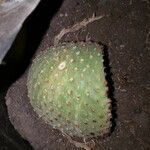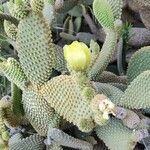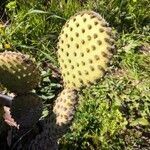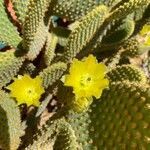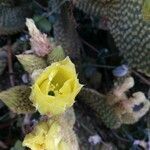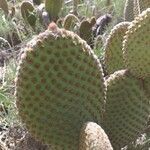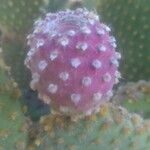Spreading shrub to 1 m high, often somewhat creeping, forming clumps to 3 m wide; trunk absent. Stem segments firmly attached, oblong, broadly obovate or suborbicular, 5–17 cm long, 6–12 cm wide, compressed, not tuberculate, green or yellowish green, dull, minutely pubescent. Areoles crowded, typically 80–100 on each face of stem segment, 4–15 mm apart, circular, 3–3.5 mm wide, not raised, with wool white to tan, ageing grey. Leaves succulent, terete, conical, 3–4.5 mm long, caducous. Spines absent. Glochids numerous, nearly filling areole, usually yellow or pale brown (in Australia) or whitish (in the form previously known as O. microdasys var. albispina, not in Australia), or reddish brown (in the form previously known as O. rufida, not in Australia), to 3 mm long. Flowers 30–50 mm diam.; outer tepals with green centres and yellow margins, often tinged red, succulent, lanceolate, acute to truncate; inner tepals yellow, ageing peach, spreading, broadly cuneate, 30–40 mm long, 17–20 mm wide, the apex obtuse, entire or somewhat erose; staminal filaments off-white, anthers yellowish; style pale greenish yellow, stigma lobes green; pericarpel (at anthesis) tuberculate, spineless. Fruit solitary, subglobose to ovoid, 25–25 mm long, 15–20 mm diam., umbilicus not deep, not tuberculate, spineless, dark or purple red at maturity, succulent. Seeds 2–3 mm diam.
More
Shrubs, erect to sprawling, to 1 m, with many small stem segments. Stem segments not disarticulating, bright green, flattened, circular to elliptic-obovate, (5-)7-10(-15) × (3-)4-8(-10) cm, low tuberculate, puberulent; areoles (9-)11-16 per diagonal row across midstem segment, subcircular, 2-5 mm diam.; wool white to tan, aging gray. Spines absent. Glochids numerous, nearly filling areole, usually yellow or whitish, sometimes reddish brown, to 3 mm. Flowers: inner tepals bright yellow throughout, aging peach, 25-30 mm; filaments and style white; anthers yellowish; stigma lobes dark green. Fruits red, spheric to ovoid, 20-25 × 12-16 mm, fleshy, pubescent, spineless; areoles 35-50. Seeds tan, nearly spheric (slightly flattened), 1-1.2 mm (perhaps infertile); girdle protruding to 0.5 mm. 2n = 22.
Erect or prostrate, stem-succulent shrub, up to 0.6 m high. Cladodes flattened, oblong, elliptical or obovate, 100-150 mm long, glaucous when young; glochidia usually yellow, also white or reddish brown, spines 0(1), very short. Leaves soon deciduous. Flowers many on each pad, clear yellow. Fruit purple to red when ripe, round, skin with glochidia.
A bushy cactus. Varieties can vary between 45 to 60 cm high. They can spread 2 m across. The joints can be 6-12 cm long. They are light green and oval. The flowers are yellow and 3-5 cm wide. They are cup shaped. The buds are reddish. The fruit are round and dark red.
In Australia, Opuntia microdasys is predominantly naturalised in the subarid and arid inland regions. In South Australia it has been collected around from open woodlands, mallee scrub, chenopod shrubland dominated by Atriplex vesicaria and Maireana pyramidata, and creek banks in open woodland dominated by Eucalyptus camaldulensis and Acacia. In New South Wales it is known from the Central Coast, recorded near Cuttabri and Narrabri, where growing in open grassy woodland dominated by Eucalyptus crebra, E. moluccana and E. tereticornis. In Victoria it is known from Wandown State Wildlife Reserve, in the subarid NW part of the State.
More
A tropical and subtropical plant. It needs slight shade. It needs temperatures above 10°C to grow. Plants can tolerate temperatures down to-7°C for short periods. Geelong Botanical Gardens. It grows in arid desert zones. It needs open well-drained soils. It needs full sun. It needs plant hardiness zones 9-12. Queen Sirikit BG.
